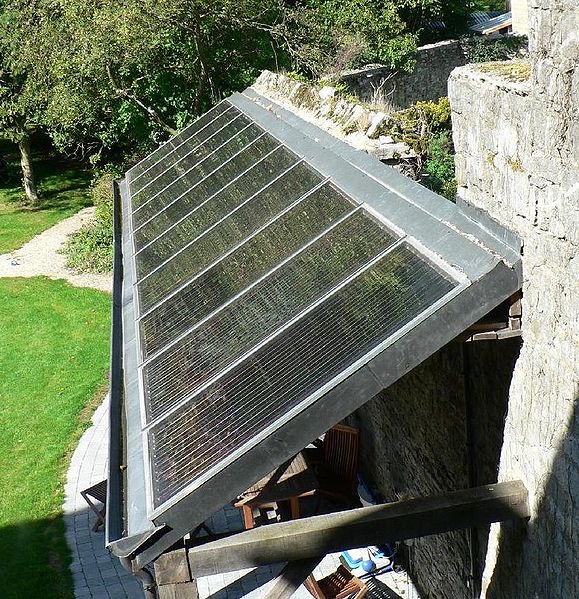Solar hot water systems collect heat from the Sun and use it to heat water for use in your home. This reduces your reliance on fossil fuels and in turn reduces harmful CO2 emissions.

Solar Hot Water – How it Works
There are many different solar hot water systems available and depending on their location and application they can be active (pumped) or passive, using natural convection currents. There are variations in the design of solar collectors, heat transfer systems and the materials used. Your circumstances, requirements and which manufacturer you use will determine the system you end up with.
On the whole, a solar system in the UK will operate something like this…
Solar collector panels face the Sun and absorb heat. Fluid is pumped around pipe-work within the panels, absorbing the heat and transporting it to a hot water storage cylinder. In most systems, the fluid travels through a coil in the cylinder, transferring heat to the water stored within, which is then distributed throughout the house.
A thermostat monitors the temperature of the water in the tank and if it falls below a certain level, heat is topped up using a supplementary heating source. This can be a compatible gas, oil or electric water heater, or, to reduce the environmental impact of the system even further, a biomass or wood burning water heater can be incorporated.
The climate in the UK is such that an auxiliary heat source is necessary for hot water needs, particularly in the winter months.
Requirements
For optimum efficiency, solar collectors should be positioned in a Southerly facing direction, although they can still operate facing West or East. If you are planning on using photovoltaic panels as well and have limited roof space then you’ll need to coordinate where each will be located.
Applications
In the UK, solar hot water systems are best suited for heating water for domestic use. It is however possible to utilise them for other applications such as heating swimming pools and supplementing space heating.
Design and Installation
As a self builder, you are in an ideal position to plan your requirements at the design stage and decide which systems to integrate into your home and how you’ll do it. Any extra space needed for the heat exchanging water storage cylinder can easily be allocated at the design phase and coordinating the system with other technologies is much easier on paper before the house is built.
Your first port of call is your designer to discuss the options, but speak to certified suppliers for an assessment of your requirements, suitable system design and more information. You may even consider using a specialist mechanical and electrical engineer if you want several technologies and the most efficient system you can.
Planning Permission
Changes to permitted development rights for microgeneration technologies in England and Scotland now mean that most photovoltaic installations can proceed without the need for planning permission.
This is dependent on the installation remaining within certain sizing criteria and as long as it is not in an area of special interest or on a listed building. Check with your local planning office before proceeding.
More Information
Visit the the Energy Saving Trust for more information and up to date estimates on solar costs, savings and capacities.
Contact solar hot water system manufacturers and installers who are certified with the Microgeneration Certification Scheme (MCS) for professional advice, system design and quotations.
Certification of the solar hot water industry is also provided through:
- The Solar Trade Association.
- The European Solar Keymark Association which provides a European-wide quality mark for solar thermal products.
Don’t forget to return to our eco homes section for other ways to make your home more sustainable and have a look through the rest of our site for more information on self building your own home.
Return to Eco Homes
Return to our Home Page from Solar Hot Water
